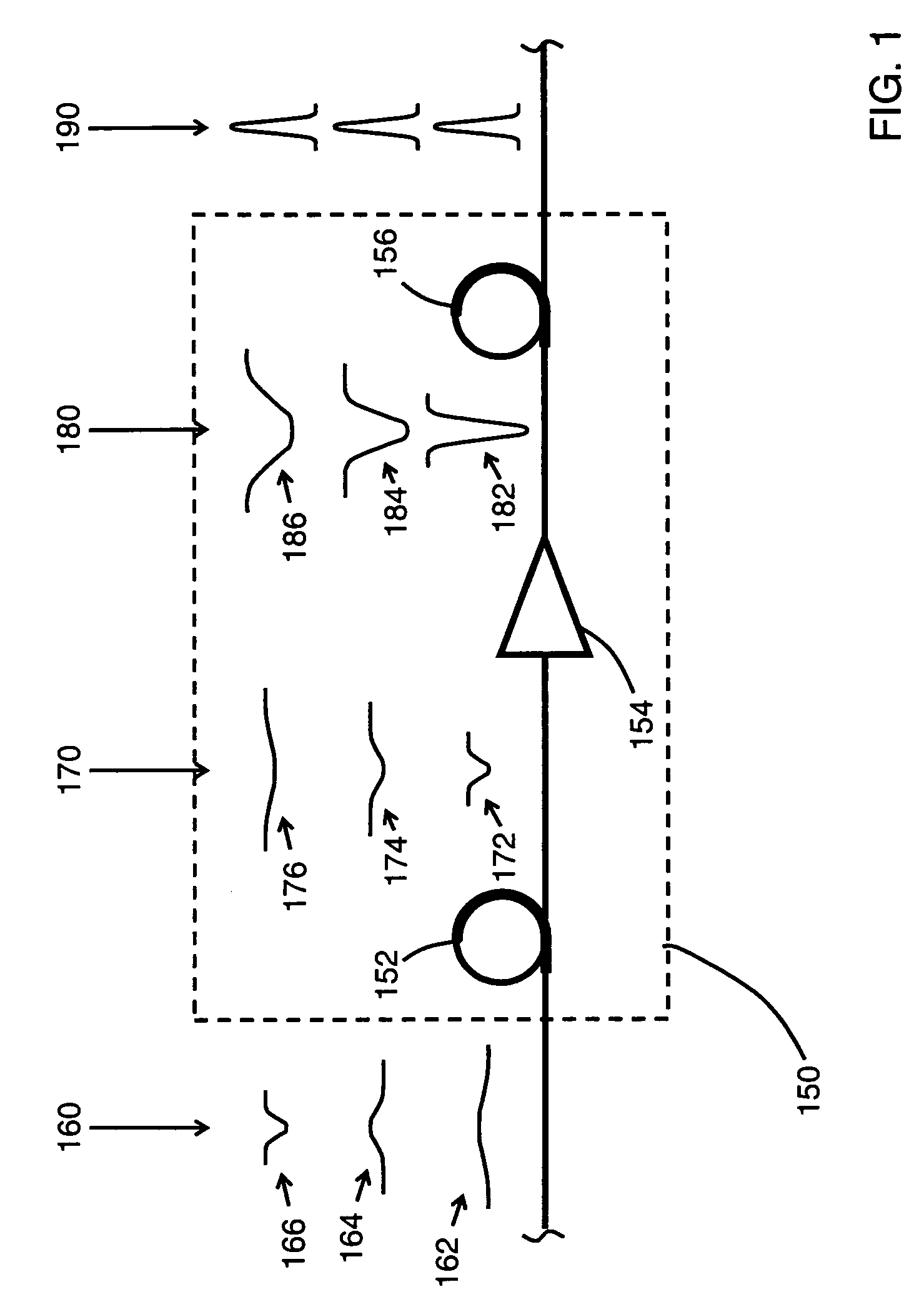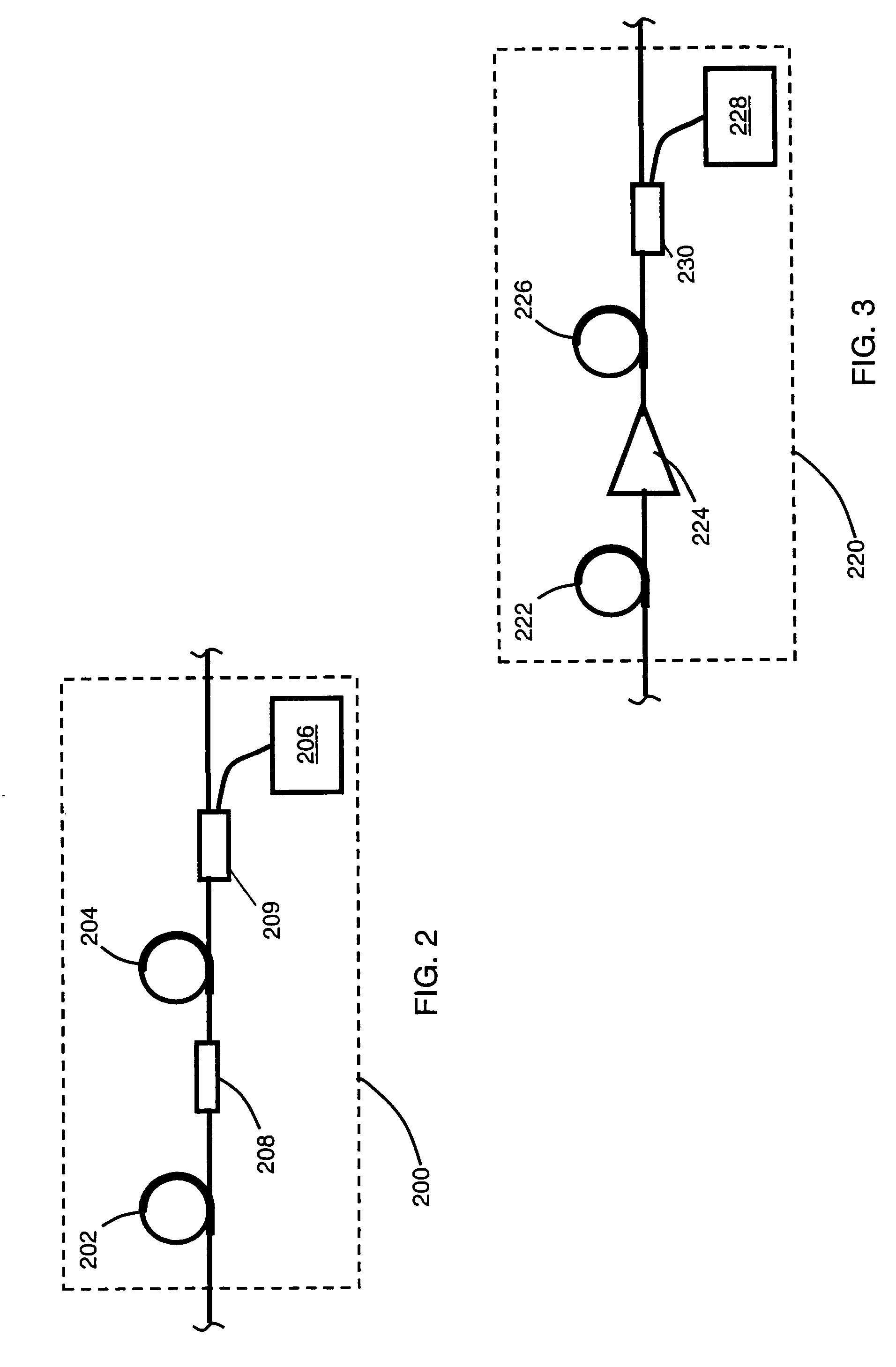Devices and methods for dynamic dispersion compensation
- Summary
- Abstract
- Description
- Claims
- Application Information
AI Technical Summary
Benefits of technology
Problems solved by technology
Method used
Image
Examples
example 1
[0099]A dispersion compensating device including a negative dispersion fiber, an amplifying device, and a nonlinear positive dispersion fiber was constructed as shown in FIG. 17. The negative dispersion fiber 340 was a dispersion compensating fiber with a dispersion of −88.9 ps / nm / km, giving a total dispersion of −42 ps / nm at a wavelength of 1550 nm and a length of 600 meters. The amplifying device 342 was an erbium doped fiber amplifier capable of providing up to 30 dB gain. A variable optical attenuator 344 was coupled to the output of erbium doped fiber amplifier to provide fine control of the amplified pulse power. Nonlinear positive dispersion fiber 346 was coupled to variable optical attenuator 324. Nonlinear positive dispersion fiber 346 was 5.773 km long and had the following properties:
[0100]
Loss at 1450 nm0.766dB / kmLoss at 1550 nm0.448dB / kmMode field diameter at 1550 nm4.416μmDispersion at 1550 nm3.961ps / nm / kmDispersion slope at 1550 nm0.0486ps / nm2 / kmSingle mode cutoff1129...
example 2
[0103]The nonlinear positive dispersion fiber 346 of the device of Example 1 was replaced with 10 km of a nonlinear positive dispersion fiber having the following properties:
[0104]
Loss at 1450 nm2.17dB / kmLoss at 1550 nm0.69dB / kmMode field diameter at 1550 nm4.478μmDispersion at 1550 nm14.5ps / nm / kmDispersion slope at 1550 nm0.0547ps / nm2 / kmSingle mode cutoff1486.82nm
The nonlinear positive dispersion fiber had a total dispersion of 145 ps / nm at 1550 nm. The same signal as in Example 1 was used. The Raman pump power was 327 mW.
[0105]FIGS. 21 and 22 show pulse width and dispersion for various levels of amplification. About 38 ps, or about 120 ps / nm dispersion of the pulses is compensated by the device. The threshold power for achieving nearly total compensation was about 40 mW; this power could be reduced by using a nonlinear positive dispersion fiber having a lower loss. FIG. 23 shows the spectral and waveform details of the pulses at signal powers of 5.9 mW, 18.7 mW, and 47.2 mW. Only ...
example 3
[0106]In order to further increase the dynamic compensation range, the nonlinear positive dispersion fiber 346 of the device of Example 2 was replaced with 15 km of a nonlinear positive dispersion fiber having the following properties:
[0107]
Loss at 1450 nm0.809dB / kmLoss at 1550 nm0.449dB / kmMode field diameter at 1550 nm5.0939μmDispersion at 1550 nm17.38ps / nm / kmDispersion slope at 1550 nm0.0526ps / nm2 / kmSingle mode cutoff1416.42nm
The nonlinear positive dispersion fiber had a total dispersion of 260.7 ps / nm at 1550 nm. The same 10 Gb / s signal as in Example 2 was used. The Raman pump power was 300 mW.
[0108]FIGS. 24 and 25 show pulse width and dispersion as a function of pulse power. At low powers, the high dispersion of the nonlinear positive dispersion fiber imposed a large positive dispersion (˜250 ps / nm) on the signal. At a pulse power of about 48 mW, nearly complete compensation of dispersion was achieved. Pulsewidth and dispersion remained essentially constant at pulse powers rangi...
PUM
 Login to View More
Login to View More Abstract
Description
Claims
Application Information
 Login to View More
Login to View More - R&D
- Intellectual Property
- Life Sciences
- Materials
- Tech Scout
- Unparalleled Data Quality
- Higher Quality Content
- 60% Fewer Hallucinations
Browse by: Latest US Patents, China's latest patents, Technical Efficacy Thesaurus, Application Domain, Technology Topic, Popular Technical Reports.
© 2025 PatSnap. All rights reserved.Legal|Privacy policy|Modern Slavery Act Transparency Statement|Sitemap|About US| Contact US: help@patsnap.com



